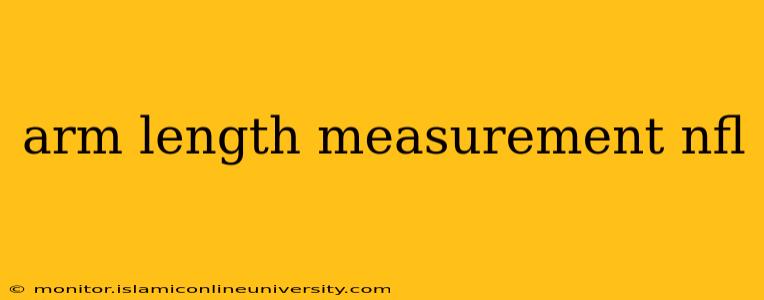Arm length is a crucial physical measurement in the NFL, particularly for quarterbacks, wide receivers, and defensive backs. It significantly impacts a player's performance and potential. This comprehensive guide explores the importance of arm length, how it's measured, and its implications for different positions.
Why is Arm Length Important in the NFL?
Arm length plays a critical role in several aspects of the game:
-
Quarterbacks: Longer arms allow quarterbacks to deliver passes with more velocity and accuracy, especially when facing pressure. A longer reach also contributes to improved throwing mechanics and a greater ability to extend the ball away from defenders.
-
Wide Receivers: Longer arms provide a distinct advantage in catching passes, especially contested catches where defenders are close. It improves the receiver's catch radius, making it easier to secure the ball despite tight coverage.
-
Defensive Backs: Longer arms are beneficial for defensive backs, allowing them to better deflect passes, disrupt receivers at the line, and make interceptions. The extra reach can help in disrupting passing lanes and making plays on the ball.
How is Arm Length Measured in the NFL?
Arm length in the NFL Scouting Combine and other pre-draft evaluations is measured from the tip of the middle finger to the acromion process (the bony projection of the shoulder blade). This standardized measurement ensures consistency and comparability across players. It's crucial to understand that this is a specific measurement – not simply the length of the arm from shoulder to wrist.
What is Considered a Long Arm Length in the NFL?
There's no single definition of "long" arm length. It's relative to the player's height and position. For quarterbacks, a longer arm length is generally advantageous. Similarly, for receivers and defensive backs, a longer arm length than average for their height usually translates to a considerable competitive advantage. However, shorter arm lengths are not necessarily a disadvantage – many successful NFL players have shorter arms. The ideal arm length varies considerably depending on the position.
How Does Arm Length Affect a Player's Draft Stock?
Arm length is just one factor among many considered during the NFL draft. While a longer arm length can improve a player's chances, scouts evaluate numerous other physical attributes, skills, and intangibles. Speed, agility, strength, and football IQ all play significant roles in determining a player's draft position. A player with exceptional skills and shorter arms may still be drafted high if their other attributes outweigh the shorter arm length.
Are there any disadvantages to having very long arms?
While generally considered beneficial, excessively long arms can sometimes have downsides. They may slightly impact a quarterback's throwing motion or a defensive back's agility. Balance and coordination become more critical aspects to consider for players with significantly longer arms than average.
Does arm length change over time?
Arm length is largely determined by genetics and does not significantly change during an NFL player’s career. While there might be slight variations due to injury or other factors, the measurement taken in the pre-draft process is considered a reliable indicator.
How important is arm length compared to other measurements?
Arm length is an important factor, but it's not the sole determinant of success. It contributes to the overall profile of a player, alongside height, weight, speed, agility, and strength. Scouts consider the combined effect of these measurements and the player's performance on the field to make accurate evaluations.
This information provides a comprehensive overview of arm length's importance in the NFL. Remember, while arm length is a significant factor, it's only one piece of the puzzle when evaluating a player's potential.
